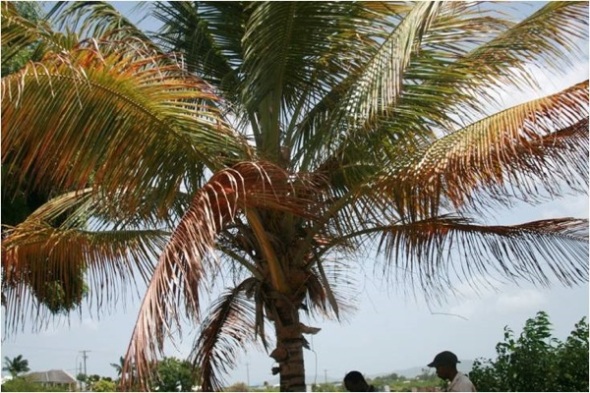Mature coconut palm displaying mid-stage foliar discoloration symptoms indicative of coconut lethal yellowing disease.
For complete article see: http://www.ndrs.org.uk/article.php?id=029012
New Disease Reports (2014) 29, 12. [http://dx.doi.org/10.5197/j.2044-0588.2014.029.012] Get pdf (819 KB)
First report of lethal yellowing disease associated with subgroup 16SrIV-A phytoplasmas in Antigua, West Indies
W.A. Myrie1*, N.A. Harrison2, L. Douglas1, E. Helmick2, J. Gore-Francis3, C. Oropeza4 and W.A. McLaughlin5
1 Coconut Industry Board, 18 Waterloo Road, Kingston 10, Jamaica W.I.
2 Plant Pathology, University of Florida, 3205 College Avenue, Ft Lauderdale Research and Education Center, Davie, FL 33314, USA
3 Ministry of Agriculture, Lands, Marine Resource & Agro Industry, The Plant Protection Unit, Queen Elizabeth Highway, P.O. Box 1282, St. John’s Antigua
4 Centro de Investigación Científica de Yucatán, A.C., Merida, Mexico
5 University of the West Indies, Mona Campus, Kingston 7, Jamaica, W.I
*cocomax@cwjamaica.com
Received: 02 Dec 2013; Published: 14 Apr 2014
Keywords: Coconut, queen palm, Bismarck palm, royal palm, foxtail palm
Coconut (Cocos nucifera) is an important perennial crop. Lethal yellowing (LY), a phytoplasma-associated disease, has been devastating coconut production in parts of the Caribbean. Local officials in Antigua observed widespread mortality of palms due to an unknown disease. Coconut palm, Christmas palm (Adonidia merrillii) Chinese fan palm (Livistona chinensis), edible date palm (Phoenix dactylifera), and Fiji fan palm (Pritchardia pacifica) were most affected. This new development followed previous reports of palm mortality due to LY in St Kitts (Myrie et al., 2012), an island in the West Indies with no prior history of the disease.
The present study was undertaken to ascertain whether widespread losses of palms currently under way in Antigua is a result of recent spread of LY disease to the island. Dead and declining coconut palms with foliar symptoms suggestive of LY disease (Fig. 1) were identified at several locations throughout Antigua. Twenty-nine palms exhibiting decline (Table 1) were sampled, DNA extracted (Myrie et al., 2012) and assessed for infection by group 16SrIV phytoplasmas. Five trunk tissues from coconuts and a queen palm (Syagrus romanzoffiana) tested positive (20.7% of the sampled palms) for infection by group 16SrIV phytoplasmas by primary PCR using primer pair P1 (Deng & Hiruki, 1991) and P7 (Smart et al., 1996) and in nested PCR using group 16SrIV-specific primer pair LY16Sf2/LY16-23Sr2 (Harrison et al., 2008). Palms were reassessed by group 16SrIV-specific real-time PCR using primers 503LY16S-ANYF/503LY16S-ANYR and TaqMan® probe 503LY16S-ANYM (Myrie et al., 2011) and with positive results in 20 palms (69%) including at least one representative of six palm species. Also, Bismarck palm (Bismarckia, royal palm (Roystonea regia) and foxtail palm (Wodyetia bifurcata), that had no prior history of susceptibility to LY, were infected. Nested PCR rDNA products (1.64 kb) in RFLP analysis produced fragment patterns that were indistinguishable (Fig. 2), but could be differentiated from Texas Phoenix palm decline phytoplasma, representative of 16SrIV-D.
Pairwise comparison between rDNA sequences (1.64 kb) derived from all six phytoplasma positive palms by nested PCRs yielded sequences that shared 99.9-100% identity with each other and 99-100% identity with comparable length rDNA sequences of phytoplasmas associated with coconut palms in St. Kitts (GenBank Accession No. JX0700937) and Jamaica (HQ613873). Representative sequences from coconut (AN6, AN28) and from S. romanzoffiana (AN21) were archived in GenBank (Accession Nos. JX560529, JX560530 and JX560531, respectively). Analysis of F2n/R2 portion of all six sequences using the Phyclassifier program (Zhao et al., 2009), confirmed the group and subgroup affiliations of Antiguan palm-associated phytoplasmas as members of group 16SrIV, subgroup A. A phylogenetic tree constructed from 16S rDNA sequences confirmed that all six phytoplasma strains examined clustered with other subgroup16SrIV-A strains belonging to the coconut lethal yellows phytoplasma subclade (Fig. 3). This report will be used to inform the Antiguan authorities as to the spread of lethal yellowing disease, which will help in the establishment of phytosanitary measures.

